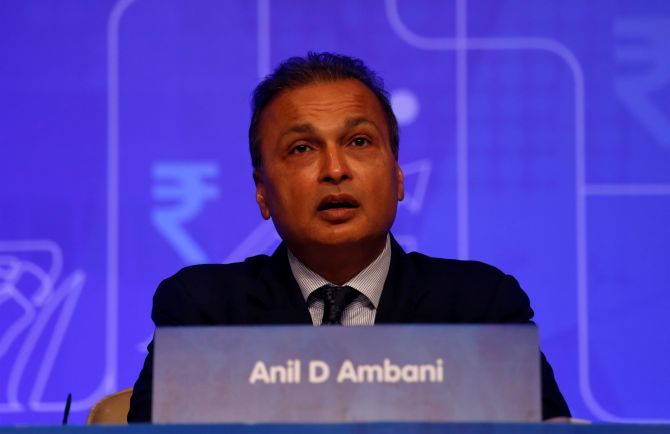 | « Back to article | Print this article |
Mukesh Ambani's Jio, high debt and some bad decisions drove RCom to its grave.

In June 2005, Anil Ambani’s estranged brother Mukesh agreed to hand him the telecom business as part of a family settlement.
Observers said Anil got a lemon while the cash cow of the group (oil and gas) was kept by his brother.
The wireless telecom Anil got had an over 20 per cent (December 2006) market share.
But bulk of users were on CDMA, a tech losing out to GSM (it had only a 3 per cent of that market).
And data, which was the cornerstone of that tech, was still not hot.
Also, his brother Mukesh’s ‘Monsoon Hungama’ scheme, offering devices bundled with voice and data at Rs 501, forced the firm (then Reliance Infocom) to write off Rs 450 crore of bad debts and disconnect 10 per cent of the subscriber base.
But the junior Ambani still took the firm on a roll with some swift action.
He shifted his bets to GSM and laid out services within 12 months.
He grabbed users through an aggressive pricing strategy (he was 60 per cent cheaper than rivals) and had an ambitious target to reach 100 million users.
Seeing an opportunity in 3G, he decided again to enter with a bang - Reliance Communications (RCom) shelled out Rs 8,500 crore to buy 3G spectrum in over 13 circles, which included the expensive Delhi and Mumbai circles.
The gamble seemed to be working - five years after accepting the family settlement, he had catapulted RCom to make it the second-largest telco in India with a four-fold increase in its customer base which hit 125 million by December 2010.
But 14 years after he took over the business, RCom, which decided to stop operations in 2017 and sell its assets to pay off Rs 43,000 crore of debt (it also got a seller in his brother with whom he had patched up), last week went to the National Company Law Tribunal (NCLT).
Its plea is to get a nod to the sale, after a committee of creditors failed to come to a consensus.
So, what changed in the last seven years for Anil to reverse what looked like a success story?
There is no doubt that the latest trigger came from Mukesh’s re-entry into telecom through Jio, which in over three years grabbed 300 million users.
Jio’s disruptive strategy forced consolidation in the industry much earlier than anyone was expecting.
And, RCom was just one of many others (TTSL, Telenor, MTS) who had to put shutters down.
As customers rushed to embrace 4G of Jio at rock bottom prices, telcos saw their market share fall.
RCom’s share fell from 9.54 per cent in June (before Jio’s entry) to as low as 5.20 per cent in October 2017.
The first signs that competition was taking its toll on RCom were evident during communications minister A Raja’s liberal dispensation of new licenses after which the number of mobile players doubled overnight to 14.
The new players unleased a price war and squeezed margins for all.
In 2012, RCom lost the No.2 slot to Vodafone, moved further down to No.4 in 2016, and its grip of the market (in October 2011 it had a nearly 17 per cent share) was clearly getting eroded.
The CBI probe, after the Supreme Court cancelled many licences, also wreaked havoc.
Even Anil, who went to court, admits it was a harrowing time. Yet the final judgment came cleared all.
A lot of time was lost to deal with the case rather than concentrating on the business.
Analysts say the other key reason for the slow decline was its growing debt burden without the commensurate increase in income.
And, one key reason to take loans, apart from investment in networks, was the hefty price of spectrum which it had to buy now through auctions, where the base price was kept very steep.
And money also had to be found to liberalise administered spectrum in the 850 MHz band for which the firm forked out over Rs 6,600 crore so it could be used for 4G.
According to estimates, nearly half of the company’s debt was to buy spectrum.
The pressure was showing. The firm’s debt doubled from Rs 25,000 crore in 2010 to the current figure of around Rs 43,000 crore.
But analysts say its net debt to earnings before interest, tax, depreciation and amortisation ratio also nearly doubled.
And with rising debt, its ability to make investments, especially in 4G, were stymied.
It tried to find solutions - one was a proposed merger with Aircel, but the deal fell through.
Could RCom have done something differently?
Some analysts point to the Bharti Airtel model, which is also facing Jio but still has been able to generate enough to invest Rs 24,000 crore annually.
And it is doing so not only through internal accruals but by smartly monetising its tower, fibre and even African telecom assets.
Analysts say RCom had many assets but it did not time the sale right.
It was offered over Rs 30,000 crore by Tillman and TPG for its tower and fibre assets about four years ago, but when it did a deal with Jio, the assets were valued at Rs 8,500 crore.
Similarly, Sun TV reportedly offered Rs 2,500 crore for a 26 per cent stake in RCom’s direct-to-home arm, which eventually it sold with no cash.
But those who have been close to the firm say that with the 4G-LTE roll-out followed by 5G, there would have been a huge upside in tenancy revenues as telcos would require thousands of more towers.
So, by waiting, it could have got a better deal.
Photograph: Francis Mascarenhas/Reuters